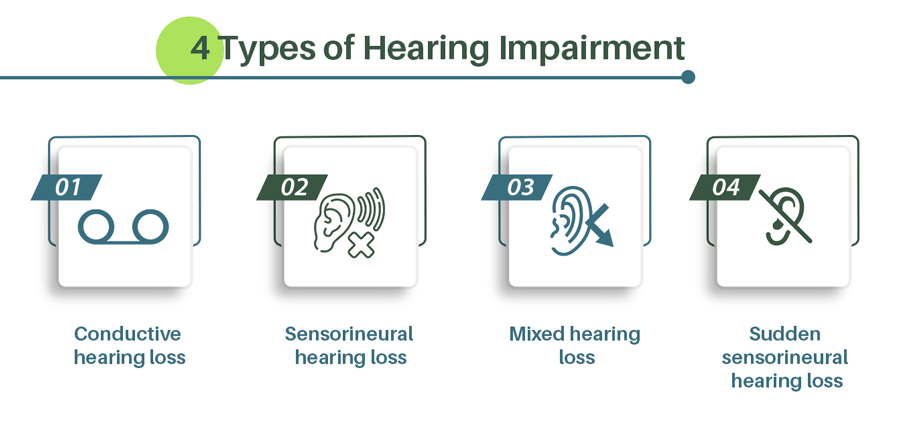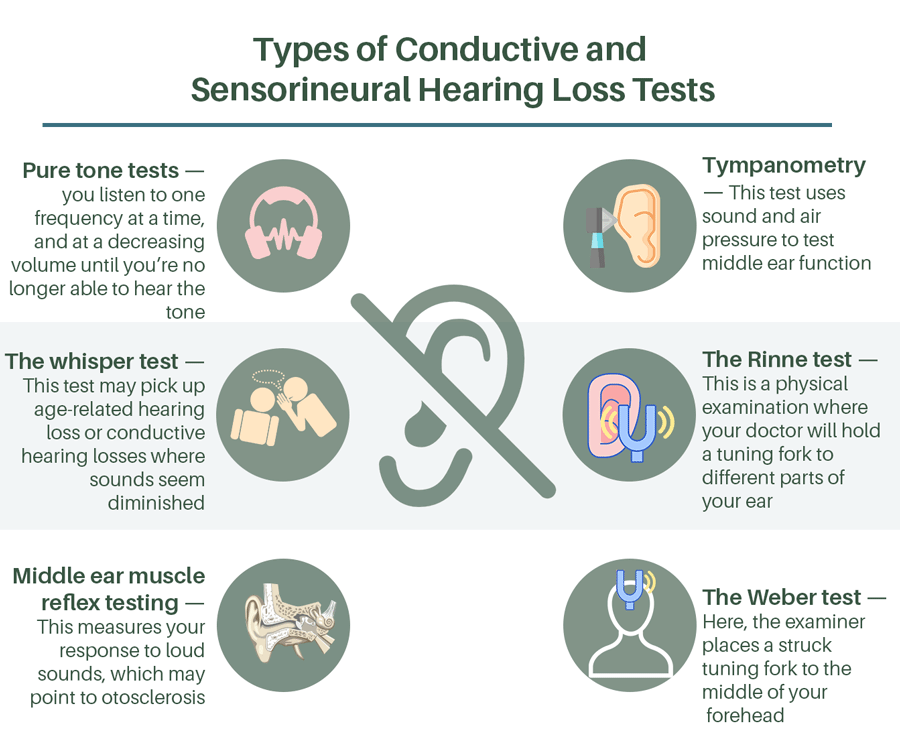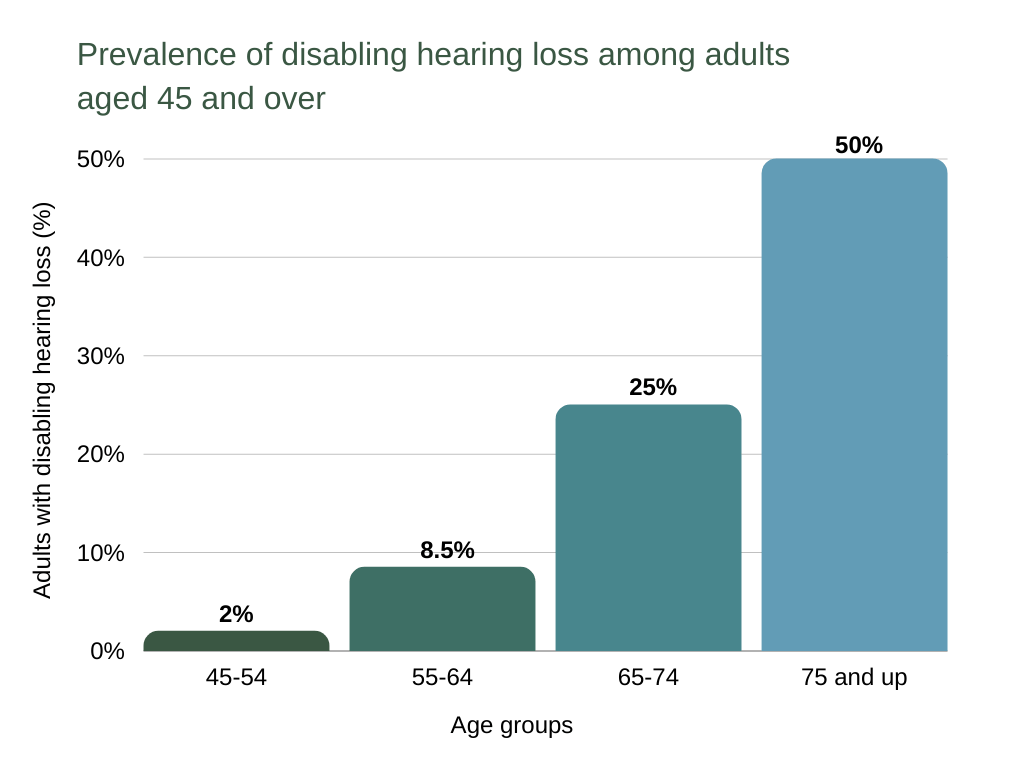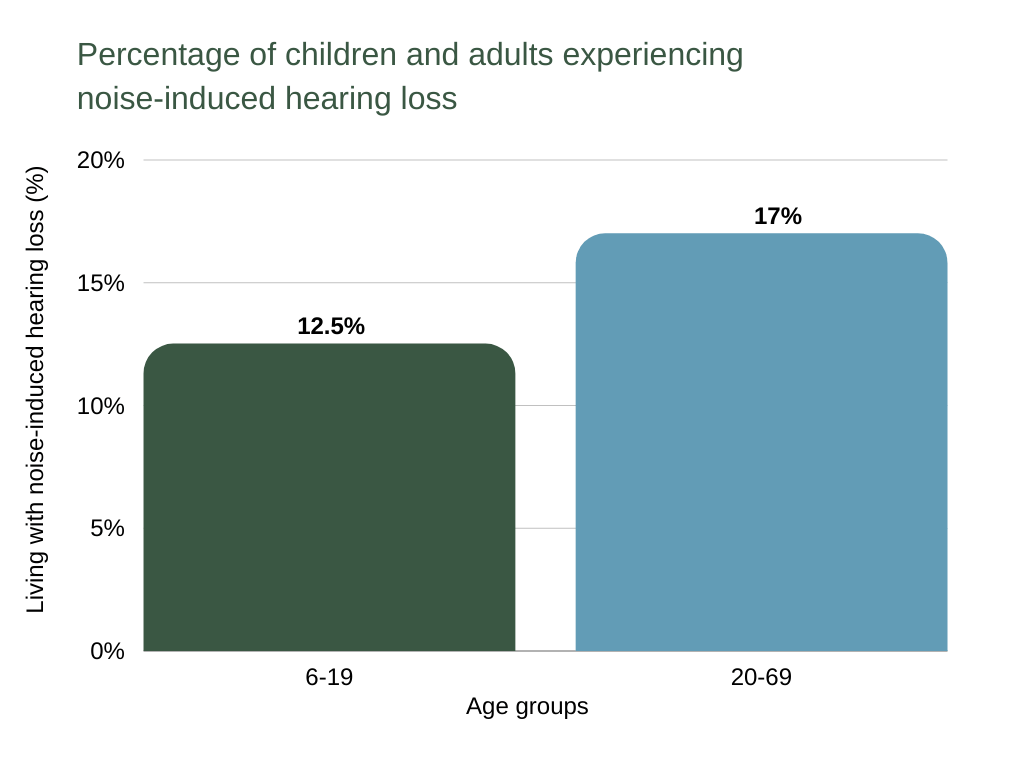You may have noticed that you find people with soft voices or accents more difficult to hear than everyone else. Maybe you regularly need to ask others if they could repeat themselves, or music is more difficult to enjoy.
Whether you’ve always lived this way or it’s a recent development, hearing loss can have a wide range of causes. So what are the different types and causes of hearing loss, and what can we do to manage them?
Key Takeaways
- Hearing loss can involve the outer, middle, or inner ear.
- Conductive hearing loss occurs when causes such as ear infections, foreign bodies, or growths in the ear canal affect sound transmission.
- Sensorineural hearing loss affects sound conversion to electrical signals and their transmission along the hearing nerve. This includes age-related hearing loss.
- Noise exposure, certain drugs, and injury are other causes of hearing loss.
- A hearing test can involve tone and tuning fork tests, or an examination of physical ear function.
- Use of a hearing aid in the affected ear, or both ears, is the main treatment for permanent hearing loss.
Conductive vs. Sensorineural Hearing Loss: What’s the Difference?
In a nutshell, conductive hearing loss involves the external or middle ear, while sensorineural hearing loss involves the connection between your ear and nervous system.
Obstruction of the ear canal or dysfunction of the tympanic membrane (eardrum) or ear bones affects conduction, or transmission of sound to the cochlea. Sensorineural hearing loss involves hair cell or nerve dysfunction. The cochlea is lined with these hair cells, which respond to sound and convert it into neural impulses [1].
In which age group is disabling hearing loss most common?

Types of Hearing Impairment
Hearing impairments fall into one of four categories:

- Conductive hearing loss.
- Sensorineural hearing loss.
- Mixed hearing loss.
- Sudden sensorineural hearing loss.
Conductive Hearing Loss
Conductive hearing loss affects the transmission of sound, its conversion into vibrations, or both. Its causes are often simpler and more localized than those of sensorineural hearing loss.
In normal hearing, sound waves are “caught” by the outer ear, and travel through the external auditory canal to the tympanic membrane, or ear drum. The sound waves are sent through the middle ear space by a set of three ear bones, to the inner ear [1].
Sensorineural Hearing Loss
Sensorineural hearing loss involves problems with converting vibrations into nerve signals. There is a dysfunction in the hair cells of the cochlea that pick up sound vibrations, or in the auditory nerve that transmits these as signals to the brain.
Unlike conductive hearing loss, where you simply perceive sounds as quieter, sensorineural loss often makes you perceive sound as both quieter and distorted [1].
Mixed Hearing Loss
Mixed hearing loss is a combination of both sensorineural and conductive hearing losses. Treatment is more difficult for mixed hearing loss, because of the need to compensate for both the inner ear and the air-bone gap (ABG) at the same time. People with mixed hearing loss generally need surgical intervention to gain substantial correction [2].
Sudden Sensorineural Hearing Loss
Sudden sensorineural hearing loss is the loss of at least 30 decibels of hearing within 72 hours or less. Its incidence is quite rare, affecting 1 in 20,000 to 1 in 5,000 people each year. Almost all cases involve just one ear, and most appear with tinnitus and/or dizziness [3].
Just under half of sudden hearing loss cases recover without treatment, with recovery more common in people with no clear cause. However, early treatment is essential, especially because the top diagnosed cause is infection. If you are experiencing sudden hearing loss right now, see your primary care physician now to be referred for, or receive, treatment.
Conductive vs. Sensorineural Hearing Loss: Causes
Many types of conductive hearing loss are caused by blockages in the outer ear or middle ear. The most common causes are accumulation of earwax, surfer’s ear (a bony growth from cold water exposure), a foreign object, or ear infections.
Most types of conductive hearing loss related to the middle ear involve damage to the ear drum. The ear drum can be retracted, inflamed, or displaced because of misplacement of the ear bones. Middle ear infection or inflammation may even cause rupture of the ear drum, which can self-resolve. In other cases, parts of the middle ear become hardened and non-functional [4].
The most common cause of sensorineural hearing loss is the biological aging process. Half of US adults in their 70s have some form of hearing loss, and this increases to 80% in people aged 85 or over. Age-related hearing loss involves degeneration in the organ of Corti, and so begins in the high frequencies [4]. Low-frequency age-related hearing loss is seen as the condition worsens.
Aging is affected by a range of factors, including oxidative stress, alcohol use, and genetics. Diabetes, cardiovascular disease, smoking, a lower educational level, and being a white male are other factors that can worsen hearing loss [5].
Other Causes of Hearing Loss
Aging, obstruction, and serious underlying problems such as cancer aren’t the only causes of hearing loss. Others include:
- Genetic conditions, which make up half of all cases of childhood hearing impairments [1].
- Injury.
- Loud noises (noise-induced hearing loss).
- Circulatory problems.
- Medication, such as tetracycline antibiotics, certain loop diuretics, and some chemotherapy drugs [4].
Noise-induced hearing loss is often caused by long-term noise exposure to sounds over 85 decibels. Many professional musicians or those in automotive fields develop noise-induced hearing loss without protection. Short-term exposure to a sound over 130 decibels can be enough to cause permanent hearing loss, too. Sometimes, this acoustic trauma resolves in 48 hours [4].
What percentage of kids and adolescents (ages 6-19) live with noise-induced hearing loss?

Hearing Loss Symptoms
The signs of hearing loss include:
- A worsening ability to hear in exposure to background noise.
- Declining ability to understand children, people with soft voices, or people with foreign accents.
- Your friends and family may start to notice that you’re talking too loud, or that you need to watch TV at an increasingly loud volume.
- A need for others to shout in order for you to hear them.
- You may also feel that your voice feels strained in an attempt to hear yourself.
Symptoms related to hearing loss depend on the underlying cause:
- An infection will often lead to ear pain and a swollen feeling.
- Some types of sensorineural hearing loss also cause dizziness, headache, or vertigo.
- In the case of Meniere’s disease, sounds may sometimes seem louder than they actually are [4].
If you suspect a hearing loss, take the Best Online Hearing Test by MDHearingAid. With this convenient online hearing test, you can see if you are in fact hearing impaired, and be pointed in the right direction as to what product may be best for you.
Conductive vs. Sensorineural Hearing Loss Tests
Tests for hearing loss range from simple questioning to imaging. Common tests for both hearing loss types include [4] [6]:

- Pure tone tests, where you listen to one frequency at a time, and at a decreasing volume. Your hearing threshold is measured by where you are no longer able to hear the tone.
- The whisper test, which may pick up age-related hearing loss or conductive hearing losses where sounds seem diminished.
- Middle ear muscle reflex testing, to measure your response to loud sounds. Impaired reflexes may point to otosclerosis, a form of conductive hearing loss.
- Tympanometry, which uses sound and air pressure to test middle ear function.
- The Rinne test, a physical examination where your doctor will first hold a tuning fork to your mastoid bone (behind your ear), then move it to your ear once you can no longer hear it. Bone conduction is less sensitive than air conduction, so an inability to hear indicates conductive hearing loss.
- The Weber test, another example of bone conduction. Here, the examiner places a struck tuning fork to the middle of your forehead. Perceiving it better in your good ear points to sensorineural hearing loss, while your bad ear points to conductive hearing loss. Normal hearing is indicated if you can hear the fork on both sides.
How Can I Manage Hearing Loss?
Hearing loss can be managed by assistive devices and accommodations, or by directly treating the problem.
Hearing Loss Treatment
You may be reading this and wondering, “can hearing loss be reversed?” If you have a conductive hearing loss caused by a blockage, especially earwax impaction, your hearing loss may be reversible. Otosclerosis, where the middle ear’s bone chain stiffens, requires either surgery or hearing aids (some of which are bone-anchored implants) [4] [6].
Foreign objects or ear wax can be removed, while growths require surgery to deal with them. An infection requires antibiotic treatment, and the sooner you receive treatment for a stubborn ear infection, the better for your long-term hearing. As for a burst eardrum, surgery to correct it is needed if it doesn’t resolve itself in two months.
Besides hearing aids, treatment for sensorineural hearing loss can involve antibiotics too, if there is a deep infection. An autoimmune cause will warrant immunosuppressive treatment, while a tumor will require surgery and other oncologic therapy [4].
Unfortunately, you are looking at permanent hearing loss if the cause is aging, genetic disease, injury, or toxicity. Early research is now examining different forms of stem cell and gene therapy as treatment options, however, which could promote regeneration in these cases [7].
Hearing Aids
Hearing aids are the main treatment options for sensorineural hearing loss. However, only 15% of Americans who need hearing aids use them consistently, due to costs and perceived embarrassment. This is despite research proving that correcting hearing loss can reduce your risk of dementia, and significantly slow disease progression.
The good news is that this is why the US Food and Drug Administration (FDA) authorized over-the-counter hearing aids in 2017. OTC hearing aids cost much less, at $200–$1,000 on average, compared to the $800–$4,000 price tag attached to prescription devices [4].
OTC hearing aids can be equal in effectiveness to prescription hearing aids, despite their cheaper price [8]. However, not all brands are equal.
MDHearingAid is one of the high-quality solutions on the market. The most popular models are VOLT+, AIR, and CORE. All three offer four environment settings covering quiet, social, and noisy areas, feedback silencing, and customizable settings. You do not need to see an audiologist every time you want to alter the volume controls.
The VOLT+ is, however, the premium option, because it is the only rechargeable and water-resistant hearing device. The CORE can adapt on its own to different settings, and create a custom “map” of your personal needs. Both the VOLT+ and CORE have dual-directional microphones, supporting your ability to hear speech sounds while minimizing excessive exposure to loud sounds.
FAQ
What are the most important things to know about hearing loss?
What Is More Common, Sensorineural or Conductive Hearing Loss?
Among adults, sensorineural hearing loss is more common than conductive hearing loss. Research has found that 40% of adults over 65 years old have age-related sensorineural hearing loss. The next most common cause of hearing loss is mixed or conductive impairment from chronic ear infection [9].
What Is Conductive Hearing Loss?
Conductive hearing loss is related to the disruption of sound transmission and its conversion into vibrations. It generally involves the outer or middle ear, with causes including infection or irritation, leading to unwanted growths.
Does Loud Noise Cause Sensorineural or Conductive Hearing Loss?
Loud noises cause sensorineural hearing loss. Exposure to dangerously loud sounds damages the hair cells in your inner ear, which prevents sound waves from being transmitted into nerve impulses for your brain to interpret.
Conclusion
While conductive hearing loss occurs as a result of sound transmission problems in the ear canal or bones in the ears, sensorineural loss involves the inner ear or auditory nerve. Mixed hearing loss is a combination of both.
Treatment for conductive loss may feature antibiotics, surgery, or bone-anchored hearing aids as a result of its causes. On the other hand, sensorineural loss is harder to treat and usually requires hearing aids to manage the impairment. If you have trouble affording a prescription hearing aid and specialized care, an OTC hearing aid may help you get your life back.
References:
- Anastasiadou S, Al Khalili Y. Hearing Loss. [Updated 2021 Jun 3]. In: StatPearls [Internet]. Treasure Island (FL): StatPearls Publishing; 2021 Jan-. Available from: https://www.ncbi.nlm.nih.gov/books/NBK542323/
- Wardenga, Nina et al. “Hearing Aid Treatment for Patients with Mixed Hearing Loss. Part II: Speech Recognition in Comparison to Direct Acoustic Cochlear Stimulation.” Audiology & neuro-otology vol. 25,3 (2020): 133-142. doi:10.1159/000504285
- Kuhn, Maggie et al. “Sudden sensorineural hearing loss: a review of diagnosis, treatment, and prognosis.” Trends in amplification vol. 15,3 (2011): 91-105. doi:10.1177/1084713811408349
- Michels, Thomas C et al. “Hearing Loss in Adults: Differential Diagnosis and Treatment.” American family physician vol. 100,2 (2019): 98-108.
- Feltner C, Wallace IF, Kistler CE, et al. Screening for Hearing Loss in Older Adults: An Evidence Review for the U.S. Preventive Services Task Force [Internet]. Rockville (MD): Agency for Healthcare Research and Quality (US); 2021 Mar. (Evidence Synthesis, No. 200.) Chapter 1, Introduction. Available from: https://www.ncbi.nlm.nih.gov/books/NBK569275/
- Danesh, Ali A et al. “The Audiology of Otosclerosis.” Otolaryngologic clinics of North America vol. 51,2 (2018): 327-342. doi:10.1016/j.otc.2017.11.007
- Omichi, Ryotaro et al. “Gene therapy for hearing loss.” Human molecular genetics vol. 28,R1 (2019): R65-R79. doi:10.1093/hmg/ddz129
- Nicholas S. Reed, AuD. “Personal Sound Amplification Products vs a Hearing Aid for Speech Understanding.” JAMA, JAMA Network, 4 July 2017, jamanetwork.com/journals/jama/fullarticle/2635618
- Zahnert, Thomas. “The differential diagnosis of hearing loss.” Deutsches Arzteblatt international vol. 108,25 (2011): 433-43; quiz 444. doi:10.3238/arztebl.2011.0433







Leave a Reply